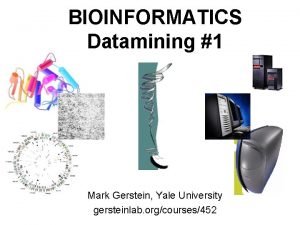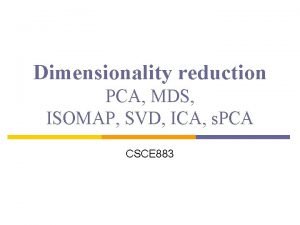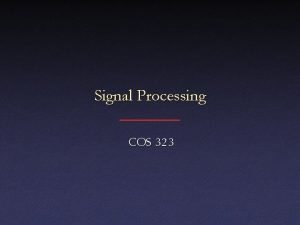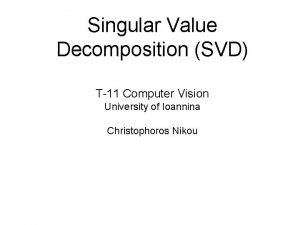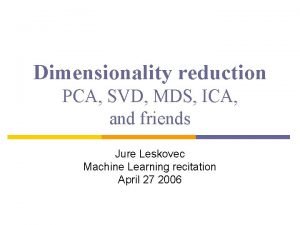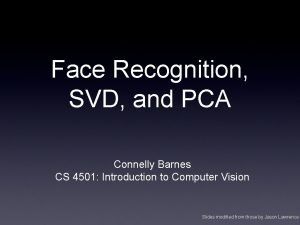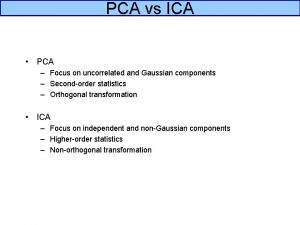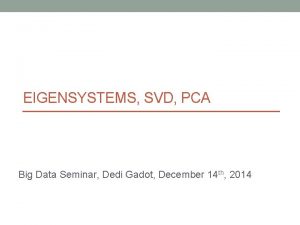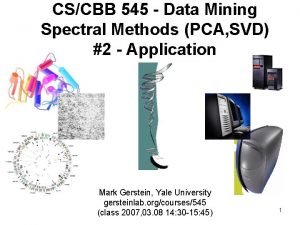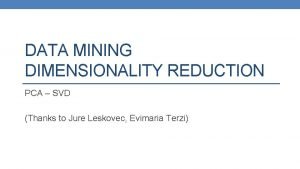SVD and PCA COS 323 Spring 05 SVD





![PCA for Relighting • Images under different illumination [Matusik & Mc. Millan] PCA for Relighting • Images under different illumination [Matusik & Mc. Millan]](https://slidetodoc.com/presentation_image_h/3167d5041358d6529899ac9ea3c941a9/image-6.jpg)

![PCA for DNA Microarrays • Measure gene activation under different conditions [Troyanskaya] PCA for DNA Microarrays • Measure gene activation under different conditions [Troyanskaya]](https://slidetodoc.com/presentation_image_h/3167d5041358d6529899ac9ea3c941a9/image-8.jpg)
![PCA for DNA Microarrays • Measure gene activation under different conditions [Troyanskaya] PCA for DNA Microarrays • Measure gene activation under different conditions [Troyanskaya]](https://slidetodoc.com/presentation_image_h/3167d5041358d6529899ac9ea3c941a9/image-9.jpg)









![Multidimensional Scaling • Result (d = 2): [Pellacini et al. ] Multidimensional Scaling • Result (d = 2): [Pellacini et al. ]](https://slidetodoc.com/presentation_image_h/3167d5041358d6529899ac9ea3c941a9/image-19.jpg)

- Slides: 20

SVD and PCA COS 323, Spring 05

SVD and PCA • Principal Components Analysis (PCA): approximating a high-dimensional data set with a lower-dimensional subspace Second principal component * ** * * Data points * * * First principal component * * *** Original axes *

SVD and PCA • Data matrix with points as rows, take SVD – Subtract out mean (“whitening”) • Columns of V k are principal components • Value of wi gives importance of each component

PCA on Faces: “Eigenfaces” Average face First principal component Other components For all except average, “gray” = 0, “white” > 0, “black” < 0

Uses of PCA • Compression: each new image can be approximated by projection onto first few principal components • Recognition: for a new image, project onto first few principal components, match feature vectors
![PCA for Relighting Images under different illumination Matusik Mc Millan PCA for Relighting • Images under different illumination [Matusik & Mc. Millan]](https://slidetodoc.com/presentation_image_h/3167d5041358d6529899ac9ea3c941a9/image-6.jpg)
PCA for Relighting • Images under different illumination [Matusik & Mc. Millan]

PCA for Relighting • Images under different illumination • Most variation captured by first 5 principal components – can re-illuminate by combining only a few images [Matusik & Mc. Millan]
![PCA for DNA Microarrays Measure gene activation under different conditions Troyanskaya PCA for DNA Microarrays • Measure gene activation under different conditions [Troyanskaya]](https://slidetodoc.com/presentation_image_h/3167d5041358d6529899ac9ea3c941a9/image-8.jpg)
PCA for DNA Microarrays • Measure gene activation under different conditions [Troyanskaya]
![PCA for DNA Microarrays Measure gene activation under different conditions Troyanskaya PCA for DNA Microarrays • Measure gene activation under different conditions [Troyanskaya]](https://slidetodoc.com/presentation_image_h/3167d5041358d6529899ac9ea3c941a9/image-9.jpg)
PCA for DNA Microarrays • Measure gene activation under different conditions [Troyanskaya]

PCA for DNA Microarrays • PCA shows patterns of correlated activation – Genes with same pattern might have similar function [Wall et al. ]

PCA for DNA Microarrays • PCA shows patterns of correlated activation – Genes with same pattern might have similar function [Wall et al. ]

Multidimensional Scaling • In some experiments, can only measure similarity or dissimilarity – e. g. , is response to stimuli similar or different? • Want to recover absolute positions in kdimensional space

Multidimensional Scaling • Example: given pairwise distances between cities – Want to recover locations [Pellacini et al. ]

Euclidean MDS • Formally, let’s say we have n n matrix D consisting of squared distances dij = (x i – x j)2 • Want to recover n d matrix X of positions in d-dimensional space

Euclidean MDS • Observe that • Strategy: convert matrix D of dij 2 into matrix B of x ix j – “Centered” distance matrix – B = XX T

Euclidean MDS • Centering: – Sum of row i of D = sum of column i of D = – Sum of all entries in D =

Euclidean MDS • Choose xi = 0 – Solution will have average position at origin – Then, • So, to get B : – compute row (or column) sums – compute sum of sums – apply above formula to each entry of D – Divide by – 2

Euclidean MDS • Now have B , want to factor into XX T • If X is n d, B must have rank d • Take SVD, set all but top d singular values to 0 – Eliminate corresponding columns of U and V – Have B 3=U 3 W 3 V 3 T – B is square and symmetric, so U = V – Take X = U 3 times square root of W 3
![Multidimensional Scaling Result d 2 Pellacini et al Multidimensional Scaling • Result (d = 2): [Pellacini et al. ]](https://slidetodoc.com/presentation_image_h/3167d5041358d6529899ac9ea3c941a9/image-19.jpg)
Multidimensional Scaling • Result (d = 2): [Pellacini et al. ]

Multidimensional Scaling • Caveat: actual axes, center not necessarily what you want (can’t recover them!) • This is “classical” or “Euclidean” MDS [Torgerson 52] – Distance matrix assumed to be actual Euclidean distance • More sophisticated versions available – “Non-metric MDS”: not Euclidean distance, sometimes just relative distances – “Weighted MDS”: account for observer bias
